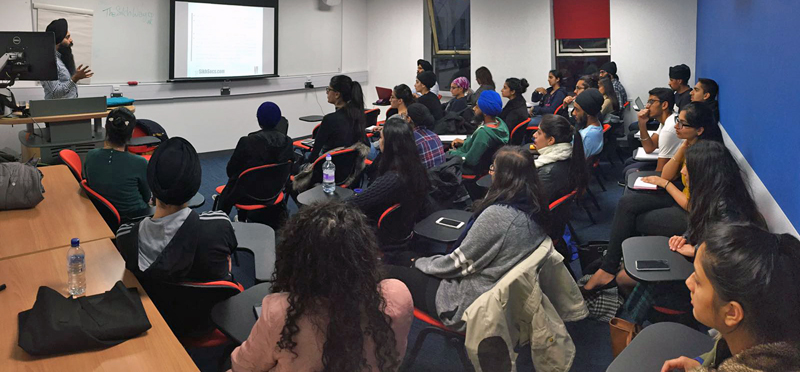Religion, ethnicity, war, cohesion, and survival
We are presently witnessing a religious uprising in Punjab. What started with the politically-oriented religious decision to pardon the head of a sect – guilty of denigrating Sikh religious traditions – has materialised into the fully-fledged struggle of a nation, struggling for survival and to uphold its sacred traditions under threat from powerful state machinery.
Many journalists and so called sociologists are trying to define the recent events of Sikh revolt from a very myopic point of view. As they have defined the Sikh militant movement, they are again up in arms with old age ‘Intellectual Tools’ to define the present struggle. Again they are presenting superficial facts and quoting Sikh history from the modern state’s point of view to justify their claims. Their analyses are as medieval as their tools are.
There is vast literature available to define and defend the Sikh struggle of survival against the overwhelming state machinery. Professor Anthony D Smith’s analysis about the formation and survival of ethnic communities against the tides of subjugation and assimilation is most vaulable. His research is self-explanatory and could be helpful for Sikh intellectuals to interpret their nation’s feelings and struggle according to the global intellectual standards. According to Smith, ethnic communities now may be defined as named human populations with shared ancestry myths, histories and cultures, having an association with a specific territory and a sense of solidarity; called ‘ethnies’ they have emerged and re-emerged at different periods and in several continents and culture-areas right up to the modern era.
“One finds a specific nostalgia, to use John Armstrong’s term, associated with nomadic and sedentary life styles, which embodies a yearning for a lost past, particularly on the part of sedentarized nomads. This nostalgia takes many forms. It may focus on desert steppes or plains, on forests or mountains, the cradle of the community or the seat of its halcyon days. It may induce a desire to return to a homeland that has been lost or a passionate attachment to the homeland that has been forged after migration.
Even more important for ethnic identity… was the implicit idea of divine selection and collective mission, the idea that ‘we’ constitute the first of the Earth’s communities, the special beneficiaries of divine activity, and that we are enjoined to lead a special life under the dispensation of a divinely ordained law-code. In this way, a special location in the cosmos lends the ethnic consciousness a sense of separation and superiority over other peoples.”
Khalsa akaal purkh ki fauj
Pragteo khalsa parmatam ki mauj
This couplet can be seen as the divine selection and collective mission. It also lends the sense of separation and superiority to Khalsa over other peoples. When this sense of oneness and belonging prevails, all fractions and factions within the community lose sense and meaning.
Smith noted that, to qualify, therefore, as an ethnic community, there must also emerge a strong sense of belonging and an active solidarity, which in time of stress and danger can override class, factional and regional divisions within the community. What we are witnessing in Punjab nowadays is the strong sense of belonging and solidarity in the Sikh nation, which has overridden all the fractions of religious and social rivalries.
For an ethnic community to survive according to Smith, it always possesses ties to a particular locus or territory which they call their ‘own’. They may well reside in that territory; or the association with it may be just a potent memory. An ethnie need not be in physical possession of ‘its’ territory; what matters is that it has a symbolic geographical centre, a sacred habitat, a ‘homeland’ to which it may symbolically return, even when its members are scattered across the globe and have lost their homeland centuries ago.
Mentioning special case of Sikhs in this respect Anthony Smith noted, clearly, the link with a territorial centre, a ‘homeland’ forms an essential part of the ‘sect-to-ethnie’ trajectory: witness the crystallization of the Sikh religion around its cultic centres, especially Amritsar. But, as important is the centrality of the book, Smith noted, and preferably a sacred tongue, in which the centres may be exalted and ceaselessly remembered. It is through these instrumentalities of land and religious book that collective memory is continually fed, and without memory, there can be no ethnicity.
Residential patterns reinforce the sense of separate ethnicity. Living in semi-segregated but interlocking quarters, or enclaves of the host society, diaspora communities like the Jew, and Armenians and Chinese were compelled to cultivate their myths and memories, their family rituals and values to keep alive a sense of collective dignity which the peculiar mixture of cultural autonomy, social scorn and political disability demanded for survival, given the difficulty of assimilation.
Smith noted that as sense of solidarity, belonging, attachment with homeland and the importance of sacred book and tongue is important for a sect to crystallize as a fully fledged ethnic community, the role of priests is as important to uphold the sacred tenets of that community.
According to Smith, the Sikh community began its existence through a religious schism; its holy books and temple priests in north-western India provided a focus for the growth of religious communal ties and sentiments…
Organized religion “supllied much of the personnel and communication channels for the diffusion of ethnic myths and symbols. The priests and scribes not only communicate and record and transmit these legends and beliefs, but they also serve as the chief guardians and conduits of the symbolism which can link feudal or imperial elite to the peasant masses… In this way, they preserved and intensified the common sentiments and ideals circulating in the community, adapting a wider religious doctrine and ethic to the special needs and interests of the culturally distinct and historically self-conscious population.”
In this respect the heroism of the sacred soldiers of the community act as a bonding factor in the community, Smith noted. According to him, “the frequency, intensity and duration of wars between rival polities is itself a significant factor in crystalizing ethnic sentiments among affected populations. During the war, the ‘bonding’ factor is even more importantly served by myth-making processes. Mobilization and propaganda are after all, ephemeral. But the myths of war, set down in epics, ballads, dramas and hymns, possess a long term power to shape distant reactions that far outweigh and surpass the episodes themselves. Tolstoy’s account of Borodino, may be far more effective in the shaping of subsequent generations of ethnically conscious families than the events themselves.” In wars according to Smith, “relations of alliance and conflict help to sharpen a feeling of self-differentiation between the communities involved in these political relations over a long period. In that sense, it is not society or ethnicity that determines war, but conflict itself which determine the sense and shape of ethnicity. War may not create the original cultural differences, but it sharpens and politicizes them, turning what previously were ‘ethnic categories’ into genuine integrated ethnie, aware of their identities and destinies. …battle myths are even more crucial for maintaining ethnic sentiments in later generations than the initial events, and that a community’s geo-political location, its relationship with other communities and polities, and especially the nexus of states in which it finds itself, helps to feed and keep alive the members’ sense of common destiny.
Hence ethnic survival consists ultimately in the continuity in sufficient numbers and force of those ethnic forms and traditions which can exert a binding and distinguishing influence on the outlook and sentiments of a population, and which, though their specific contents may change, are yet able to replenish themselves among that population.
Forms must have significance for at least a section of the population unit, and traditions must live and thrive among them, if the sense of ethnicity is to be diffused and transmitted to future generations.”
Smith said, “if the forms lose their meaning, if the traditions become ossified and cannot be developed anew the ethnie falls into cultural decline, however prosperous and powerful its individual members or their polity may be.”
So in this background of Anthony Smith’s research and his deep insight into the formation of ethnic communities and their struggle for survival, we have to observe and define the Sikh militant movement, the role of priests and religious leaders like Sant Jarnail Singh Bhindranwale and the role of the religious leadership of the present Sikh struggle in Punjab. Myopic and doctored views about the ideological aspects of Sikh struggle are the attempts to deliberately deviate the philosophical aspects of the yearning of Sikhs to get their homeland which has been lost in the 19th century.





